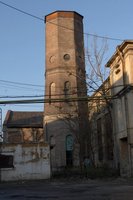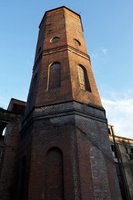
One of the things I found during these dreamy cruises was a watertower near the student campus of Grozavesti. I would see it pop into my window only to disappear after a few seconds. The bus was rushing towards its next stop. The selection and storing process seemed to me a nuisance at that time. Dreams, people, objects came towards me and then went away, and I did not care to interfere with this flow.
Later on I started studying the recent history of Bucharest. My expectations were very much linked to the dreamworld I was living into at that time, a world enhanced by reading. But the historians of the city lived in a world of facts. Bucharest was the only city that was completely demolished during the time of peace, and then rebuilt in a gruesome manner.
Ugly blocks and the huge toxic corpse of the House of the People invaded my revery. My thinking became grave and serious all of a sudden, as I was continually contemplating an apocalypse of built space in my head.
Cruising through the city became a very sad event. As I had studied the dymamics of demolition in great detail, every building seemed to shout its decay and uncertain future through the windows of the trams and buses that took me home. Their precarity was disgusting, and I had to give up this way of seeing my city if I were to look at it with friendly eyes again.
In 2004 I submitted a contribution to the fanzine incepem. It was a print containing an image of a watertower near my home. As the title of that issue was 'future' the text read:'maybe in the future I will climb into the watertower near my home, on Vergului Street 21, and I will fly with it into outer space.'

I was startled by the sheer oddity of that tower that looked like a flying saucer. It blew to pieces my preconception of my neighborhood. I was indeed living into an area built mainly as a dormitory by functionalist Communist urbanism. But all inhabited and built spaces, as uniform as they might be, seemed to have their hidden marvels. The huge science-fiction shaped tower, put my imagination to work.
At once, the hidden beauty of a trampled and decaying city was revealed to me. The maps of the destructive totalitarian urbanism were replaced in my head with those created by the journeys implied by my new, completely futile hobby. Taking photos of all the watertowers in Bucharest became my new mission.
At last, inside this futility I seemed to thrive and live my dream of the city in silence and peace. Towerspotting was indeed of no practical relevance, I thought. Then, during some internet searches, I found what I thought to be amazing watertowers' posters, in black and white. They were collection of photographs, taken by the German artists Bernd and Hilla Becher.

Later on, on a Tate webpage, I found a commentary of their work. Impassionate photographers of industrial architecture, the Bechers placed their cameras before watertowers, mills and other industrial installations, creating series of photos that were typological studies on similar object morphologies. They were members of the minimalist movement in photography. They even created their own personal style and founded a school of minimalist photography (of which Andreas Gursky was a disciple).
The Bechers had a method of producing photographs that they used all their lives. The method I used is somewhat different. First of all I am not a photographer, so my aims differ somewhat from those of the Bechers. I consider towerspotting to be a documentation project on the specific industrial objects I have chosen to observe.
It is also a quest for a city more complex than any historical description. Towerspotting involves motion towards the object of someone's (futile) quest. I take each discovery as a personal conquest of a place within the city. It is a gesture of appropriation of space, as much as it is archive work. To this end it is also work on the memory of the space we live in. Many people forget that there are other architectural objects around them, besides the threshold of their homes and the door to the office.


The documentation method I use consists of two perspectives on a watertower. One of the photos aims to integrate the tower within its respective industrial area. It is a general view.
The second is a photo taken from the base of the tower. It aims at enhancing the monumentality and oddity of the object. I have chosen this perspective because I believe that the different and the marvellous need to be added to a vision on the city that is both unifom and monotonous.
Since I started taking photos in October 2005, the project has exploded. I am now a member of the International Watertower Society (and yes, indeed it sounds like an English, completely useless hobby, with a bunch of people dedicated to some obscure object of research).

My friends keep on giving me information about new towers they spotted somewhere in the city. For this I have devised a map, marking visited and photographed towers and new discoveries. Currently, the site is available only in Romanian. The site also hosts a small collection of photographs of rooftops, deserted buildings and deserted parks.

Whenever I visit any of these places during a session of urban exploration I am surrounded by my restored dreamworld as well as by the respective historical information coming from my reading. These perspectives blend together into a wholesome view of my city, with its collection of marvellous, repulsive, toxic and dream spaces.

No comments:
Post a Comment